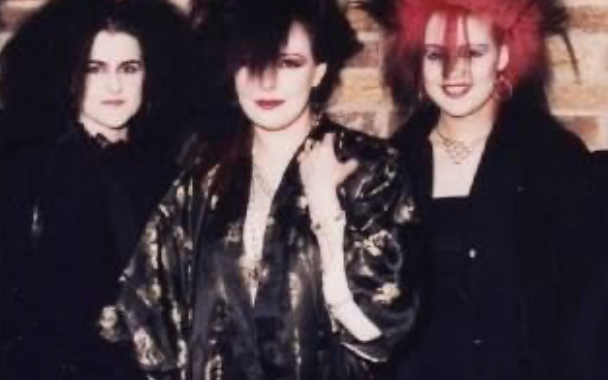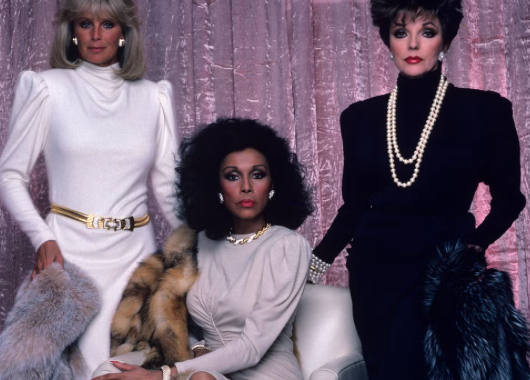Bringing the 80s to Life Through Photography
- siennasinclaire
- Jun 13
- 7 min read
Updated: Jul 24

Why The 80s Still Captivates Us
For me, the 80s weren’t just a cultural moment—they were personal. I grew up in my dad’s hair salon, surrounded by hairspray, creativity, and the constant pulse of MTV. While other kids watched cartoons, I studied music videos, absorbing the bold fashion and powerful women that defined the decade.
My version of the 80s wasn’t neon—it was black and white, soft pastels, and pure attitude. You saw it in rock videos, Miami Vice, and right inside my dad’s salon, which had black-and-white checkered floors and all the edge of an 80s music video set. He had long, Sebastian Bach-style hair and the looks to match—basically a rockstar behind the chair.
I’d dress up in black lace, tease my hair sky-high, and pose while my dad took photos of me like one of his clients. That was my first experience with styling, confidence, and creative direction. Today, my own studio has black and white checkered floors—a tribute to where it all began.
The 80s still captivate me because they weren’t just flashy—they were expressive. There was emotion behind the fashion, and storytelling behind the music. That’s exactly the energy I bring into every 80s-inspired shoot I create now.
Understanding 80s Fashion - And It's Not Neon
When most people think of 80s fashion, they picture everyone wearing neon head to toe. But that barely scratches the surface. The truth is, 80s style was far more complex—and far more sophisticated—than the clichés suggest.
One of the biggest influences on 80s fashion and design came from the 1920s. The decade borrowed heavily from Art Deco aesthetics and Egyptian motifs, incorporating black lacquered furniture, gold accents, mirrored surfaces, and sharp geometric shapes.
That influence showed up in fashion too—through sequins, fringe, feathers, drop-waist dresses, and dramatic silhouettes. Coco Chanel’s tailored suits of the 1920s redefined women’s fashion with structure, elegance, and authority—laying the groundwork for what would later become the iconic 80s power suit.
But the influences didn’t stop there. The Victorian revival made its way into 80s fashion through high collars, puffed sleeves, lace gloves, corset-inspired details, and romantic silhouettes. This trend evolved into the New Romantics movement, where fashion collided with performance art—think ruffled shirts, velvet, dramatic makeup, and flamboyant glam. Artists like Adam Ant and Duran Duran led the charge, blending elegance and edge into something theatrical and unforgettable.
You also had the rise of goth and new wave style—subcultures that rejected the mainstream with their own distinct aesthetics. Goth brought in moody black lace, religious iconography, dark lipstick, and layered, Victorian-inspired fashion. Meanwhile, new wave style embraced asymmetry, gender fluidity, angular cuts, and exaggerated accessories—paired with bold colors or stark monochrome to create high-impact visuals.
And let’s not forget the 50s revival, think Marilyn Monroe meets Madonna. But it wasn’t just about curves and glam—it was also about attitude. Women borrowed from the 50s menswear playbook, rocking cropped leather jackets, cuffed jeans, and greaser-inspired short haircuts that flipped gender norms on their head. The classic white t-shirt and denim combo got a rebellious makeover, especially in the hands of Madonna—who layered it with lace gloves and stacks of jewelry.
The 50s revival showed up in music and film too. Rockabilly influences made their way into stage looks, music videos, and mainstream style. And in movies like Back to the Future and Grease 2, retro Americana collided with 80s energy—reminding everyone that the past could be reimagined, not just repeated.
And finally neon didn’t really show up in fashion until the very end of the decade ('87), and even then, it carried over more into the 90s. It was there but it wasn't popular until the end of the 80s. I didn’t own anything neon in the 80s, and honestly, I didn’t know anyone who wore it either except for seeing it on MTV.
The real color palette of the 80s? Pastels. Think soft pinks, icy blues, and seafoam greens—pure Miami Vice energy. Sure, there was neon signage and bold graphic art in the background this tv series but it was all pastels for the fashion. And it wasn’t just fashion—pastels took over home decor too.
The Black + White Side of the 80s
When most people think of 80s fashion and design, they picture neon. But for me, the true color of the era was black and white.
It was bold, graphic, and everywhere—from fashion to interiors to pop culture icons. The Memphis Design Movement didn’t just play with color; it used black and white to ground its wild geometric shapes.
Checkered floors made a huge comeback, showing up in salons, boutiques, and homes—my dad’s salon had them, and I’ve continued the tradition in my own studio today. It’s not just nostalgic—it’s timeless.
In fashion, black and white made a statement. Madonna wore it like armor—lace gloves, bustiers, layered pearls—all part of her early signature look. Designers mixed stripes, polka dots, checkerboards, and graphic prints, often adding a single pop of red or neon for contrast. Even I had my favorite black and white pieces growing up—graphic pants and a striped tank top I wore on repeat.
You saw it on screen too. From the leather fringe outfit in Can’t Buy Me Love to the high-glam looks on Dynasty and Princess Diana’s iconic monochrome ensembles, black and white dominated the decade. Rock stars—from Joan Jett to glam metal frontmen—wore it head to toe, turning it into a uniform of rebellion and cool.
Even polka dots made a major comeback, a nod to the 50s reimagined with oversized prints and edgy styling.
So while most people remember the 80s in neon, I remember it in black and white—with attitude, contrast, and an unforgettable sense of confidence.
80s Lighting Essentials
Lighting is one of the most powerful tools for evoking the 80s—and in that decade, subtlety wasn’t the goal. The 80s were cinematic, high contrast, and unapologetically stylized. Whether you’re channeling an album cover, a fashion ad, or a scene straight out of a music video, your lighting choices will make or break the aesthetic.
To capture that electric mood:
Use colored gels on your lights—deep pinks, moody purples, icy blues, and hot reds all evoke that signature 80s palette.
Combine harsh, direct flash with dramatic shadows for a gritty, editorial look.
Add backlighting and haze to mimic the dreamy, surreal feel of an 80s nightclub or soft-focus fashion commercial.
Style With Character, Not Costume
The difference between an iconic 80s shoot and a cheesy one always comes down to intention. You're not just dressing someone in vintage for fun—you're creating a persona.
The 80s were about attitude, confidence, and storytelling through style. Your model shouldn’t look like they’re headed to a costume party—they should look like they belong in the era.
And here's the secret: you don’t need to rely solely on vintage. In fact, I rarely do. I style all my 80s-inspired shoots using current pieces from my own clothing store, Naughty Girl. Every item in the shop is hand-picked with a bold, confident woman in mind—and many of them naturally channel that fierce, 80s aesthetic. Think strong silhouettes, power shoulders, bold textures, and details that nod to the decade without feeling stuck in the past.
To nail the 80s vibe:
Mix vintage and modern for a fresh take—think a structured blazer with high-cut mesh bodysuits or sequin pieces with edgy boots.
Lean into texture and shape: leather, mesh, metallics, shoulder pads, cinched waists, sharp tailoring.
Experiment with different colors/patterns: Try black and white pairings (a classic 80s contrast), soft pastels, bold geometric patterns, or all-over monochrome looks.
Accessorize with drama: chunky gold jewelry, oversized belts, lace gloves, bold sunglasses, layered pearls to knee high boots.
Hair And Makeup Should Have An Edge
If there’s one thing you should never do when channeling 80s beauty—it’s play it safe. The 80s were a celebration of excess, and hair and makeup followed suit. Think volume, drama, color, and contour. Everything was turned up.
Hair should be big, bold, and full of personality. Tease it, spray it, sculpt it. Whether it’s voluminous curls, a high ponytail, or slicked-back with a glossy finish, it needs to make a statement. This was the era of glam rock, supermodels, and editorial edge—and the hair reflected that.
For makeup, color was power. Eyeshadow palettes were unapologetically bold—electric blues, shimmering purples, vibrant metallics—paired with strong eyeliner that defined the eyes with confidence. Lips were equally daring: glossy reds, deep berries, or sharply outlined nudes that framed the face with intention.
Don't be afraid to play with asymmetry or strong lines in your beauty looks. The 80s embraced angles and attitude, which translated into both hair shapes and makeup techniques. Think bold brows, sharp blush placement, and unconventional silhouettes.
Design A Set That Tells A Story
In 80s-inspired photography, the set isn’t just a background—it’s part of the fantasy. The moment someone sees the photo, they should feel like they’ve stepped into a different world. That means creating a scene with purpose, mood, and personality—not just placing your subject in front of a blank wall.
Think beyond props and backdrops—start building visual moments that evoke emotion and narrative. Are you recreating the cover of an album? A scene from a movie? A fashion ad? Maybe your subject is a movie star or singer.
Glamour Shots: One of the most recognizable photography trends from the era was the neon-lit Glamour Shot. These portraits were everywhere—complete with soft-focus lighting, dramatic makeup, and vibrant backdrops in electric pinks, purples, and blues. You can modernize this iconic look by keeping the glow but switching up the styling, posing, or lighting technique to give it a contemporary edge.
The Memphis Design Movement: You can also take inspiration from the bold design elements that defined 80s aesthetics. The decade loved geometric shapes—triangles, circles, squiggles—in pastel and bright color palettes, often arranged in angular, architectural ways. Recreating a backdrop with hand-cut shapes, painted panels, or vinyl decals in these tones is a great way to instantly set the era.
Incorporating mirrored surfaces or black-and-white checkered floors can add just the right amount of visual drama. Bold graphic prints—whether on the walls, furniture, or even the clothing—enhance that unmistakable 80s energy. And don’t underestimate the power of props. Vintage details like rotary phones, cassette decks, old TVs, metallic beauty vanities, or chrome-and-glass furniture can bring a set to life in seconds.
Why Book An 80s-Inspired Shoot?
Whether you want to celebrate a milestone, create unforgettable branding images, or simply relive your favorite decade, an 80s-inspired shoot is pure joy.
From the lighting and styling to the story and mood, every detail is designed to make you feel like a total icon. You’ll walk away with images that aren’t just beautiful—they’re cinematic, nostalgic, and uniquely you.
If you’re craving a session that’s all about color, edge, and that unapologetic 80s energy, let’s make it happen. Book your session with Sienna Sinclaire who's an 80s photographer in Los Angeles.



















































































Comments